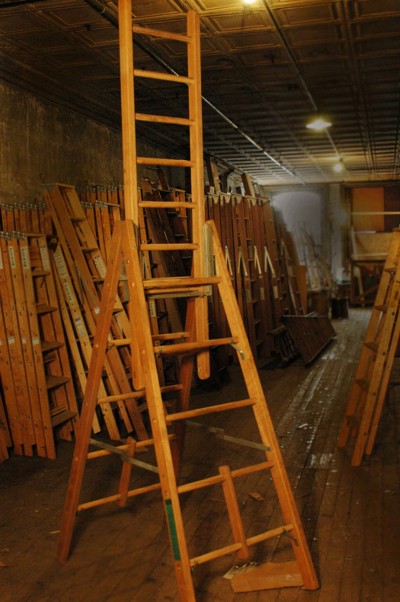
An extension trestle ladder—also known as an A-ladder—needs to be positioned properly before it can be used safely.
Supported scaffolds with a height-to-base ratio of more than 4:1 must be restrained by guying, tying, bracing or equivalent means. For example, a scaffold that measures 1.8 m (6 ft) in its narrowest base dimension is limited to a maximum height of 7.3 m (24 ft) without the additional support of being tied to a building or other structure.
The following are further tips for scaffolding safety:
- Inspect the scaffold for damage and ensure all supporting poles, legs and cross-braces are securely fastened and properly positioned.
- Never move a rolling scaffold while someone is on it.
- Never leave tools or other items atop a scaffold after your work is finished.
- Never use a ladder atop a scaffold for extra reach.
- When moving a rolling scaffold, use extra caution and, if necessary, get assistance from others. Depressions or holes in paved areas could cause it to topple during movement.
- Do not place objects with large wind-bearing surfaces (e.g. sign faces or tarps) on a rolling scaffold or, for that matter, any non-tied scaffold. In a sudden breeze, such objects act as sails, which can allow wind to topple the scaffold. In fact, it is best not to use scaffolds in windy conditions at all if they are not securely tied to a building or another structure.
Local measures
Additional precautions must be taken when working above storefronts where public access is open. The areas directly below the work being performed should be cordoned off to restrict such access.
Local jurisdictions will also enforce requirements for putting up adequate job barriers, such that if a sign installation crew fails to cordon off the work area properly, the sign company will be subject to fines.
Observing these and other safety rules will both protect personnel from serious accidents and help sign companies improve the efficiency of their field operations.
Bill Dundas is director of technical and regulatory affairs for the International Sign Association (ISA). This article is adapted from ISA Sign Academy online training resources. For more information, visit www.signs.org/online.





